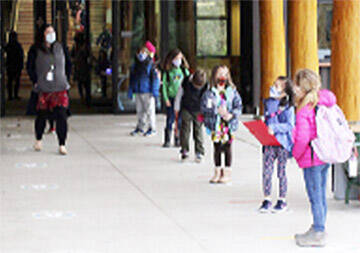As COVID-19 cases in the Bainbridge Island School District, along with the state, continue to decline the district discussed the impact of changing enrollment numbers, celebrating diversity, and improving teaching and learning.
At the Feb. 11 school board meeting, superintendent Peter Bang-Knudsen stated that COVID cases had dropped sharply since Jan. 27 when the district recorded 1,159 COVID cases compared with 465 reported Feb. 10. He also referenced Gov. Jay Inslee’s announcement to end masking this spring and stated, “The Department of Health decides to make that decision. We’ll be ready to do that, and I’m excited for that possibility this spring.”
Enrollment
Looking at enrollment for 2023, Nathan Fitzpatrick, Human Resources director, projected 3,479, 48 fewer than now. He said cohorts tend to grow from kindergarten through the fifth grade with a slight flattening between fifth and sixth grades. The 8th-grade cohort usually grows by about 40 students through ninth grade and then enrollment steadily declines in the 10th, 11th, and 12th grades due to students participating in Running Start.
As Fitzpatrick moves forward he plans to use the projections while monitoring registration numbers and transfers to align staffing to enrollment. “At the end of the day, our target is always to ensure that we’re budgeting our revenues and expenditures to ensure a 5% balance as per board policy.”
Black History Month
Bang-Knudsen highlighted some of the ways that educators were weaving Black history lessons into classes during Black History Month. The accomplishments of black NASA mathematicians Dorothy Vaughan, Mary Jackson and Katherine Johnson were honored, along with civil rights activists, politicians, and scientists and the compositions of musicians Louis Armstrong and George Walker.
“It’s been really fun going around the schools and seeing books and posters and presentations and teacher-led discussions on these topics,” Bang-Knudsen said.
He noted a flurry of creativity peaking too. Ordway students created their own Pantone color of the year and explained what it represents for them in 2022, the BHS robotics team built robots for competition, Sakai sixth-graders wrote code for their ultrasonic race bot competition and students at BHS produced three Winter One-Act plays.
He also recognized BHS students Chole Lytle and Gigi Hendrickson who received awards for their contributions to the BISD community and will be joining a panel discussion hosted by the BI Historical Museum commemorating the 80th observance of the Japanese exclusion on March 9 via Zoom.
Lytle won the Martin Luther King Jr. Inspiration Award for creating art inspired by King’s quote, “The ultimate measure of a man is not where he stands in moments of comfort and convenience, but where he stands at times of challenge and controversy.”
Hendrickson was presented with the Dr. Craig Komodo Legacy Award, which recognizes students who work to improve their school community by promoting inclusion, civil rights and social justice.
Teaching and learning
Executive Directors of Teaching and Learning Amii Pratt and Kristen Haizlip presented a District Improvement Plan mid-year update to highlight work in the areas of Teaching and Learning, Health, Well-Being and Safety, and Equity, Anti-Racism, Inclusion, Diversity and Justice.
They explained that building administrators and leadership teams have dedicated Monday afternoons to focus on professional development, and K-8 teachers are applying their learning to the classroom setting each day with the implementation of the Illustrative Math Curriculum.
Haizlip said, “We really feel like we’re seeing a shift in practice, and really important, meaningful dialogue and discourse among ourselves as colleagues and peers and then translating that into the classroom, which is directly in line with our school improvement plans and something that we’ve been essentially focused on throughout this year.”
They highlighted the use of Zaretta Hammond’s book about culturally responsive teaching that advocates for “building the learning capacity of the individual student. There is a focus on leveraging the affective and the cognitive scaffolding that students bring with them. The simplest way to judge whether your teaching is culturally responsive is whether your diverse students—students of color, English language learners, immigrant students—are learning. If they are not succeeding academically within your classroom norms, your approach might need to be more culturally responsive.”
Teachers and students find the Illustrative Mathematics program rewarding.
One teacher said, “My students love math this year! They feel challenged, love working with peers and the conceptual understanding is at a level I have not seen in the past.”
Another teacher said Illustrative Mathematics is turning out to be very accessible for a wide range of learners. “The “low floor, high ceiling” concept allows for less-experienced students to still feel actively involved in problem-solving.”
Coffee chats
If you’d like to speak with school board members in person outside of the monthly school board meetings, stop by one of the school board Coffee Chats. Board members Lynn Smith and Mark Emerson hosted the first one Feb. 11. Information may be found on the BISD website.



